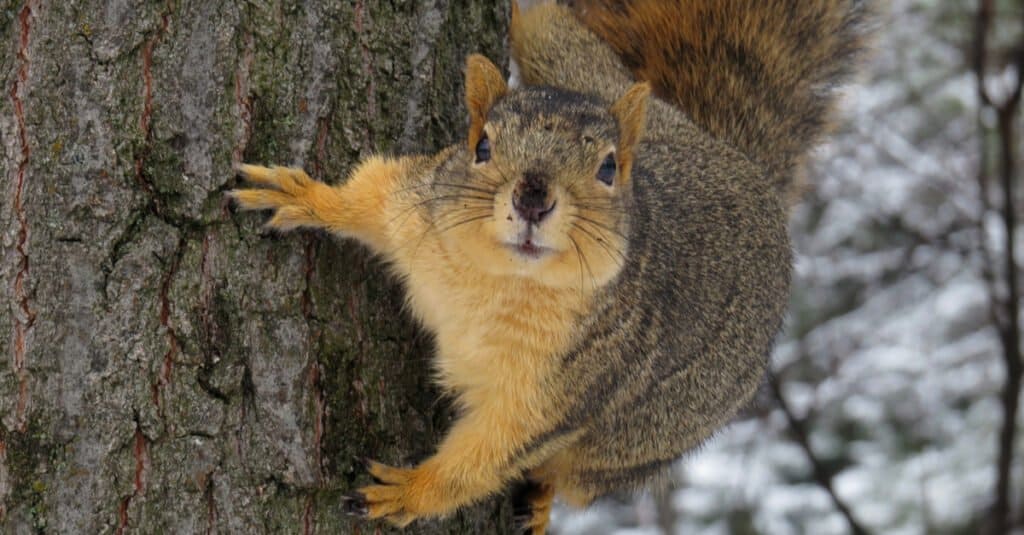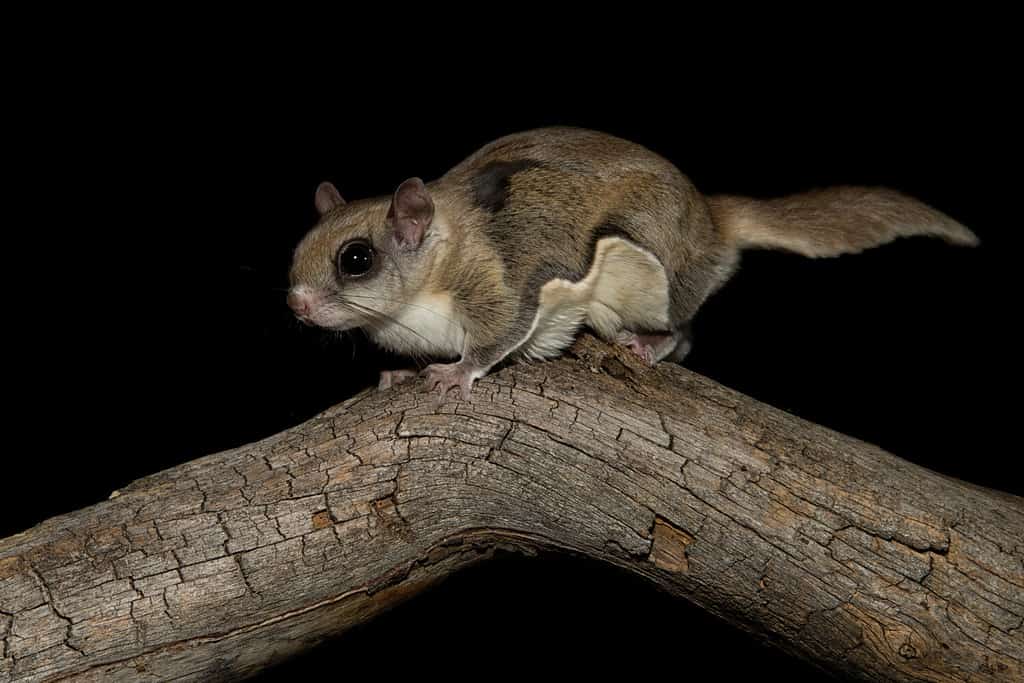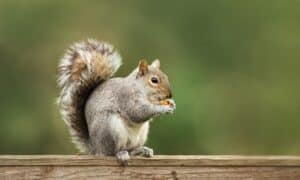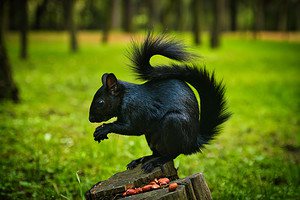Welcome to the fantastic journey of exploring the largest squirrels in Canada! Squirrels are small rodents with bright eyes and long, bushy tails known for hiding nuts and their stunning acrobatic jumps. They often live in dense forests, woodlands, and suburban areas and mainly feed on fruits, insects, and seeds.
Squirrels evoke different emotions in people. While some individuals find these furry, long-tailed rodents adorable and enjoy watching their antics, others find them a nuisance and can’t stand having them in their backyards. No matter how you feel about these rodents, squirrels are crucial to our ecosystem, providing food for predators and spreading seeds.
That said, Canada is home to roughly 22 differently-sized squirrel species. Some of these squirrels fly, others live on the ground, while others on trees. This post will look at the six largest squirrel species in Canada.
Let’s jump in.
1. Eastern Gray Squirrel (Sciurus carolinensis)
The eastern gray squirrel is one of the largest tree squirrels in Canada. They have long tails, which enhances their acrobatic abilities on trees, where these squirrels spend most of their time. Squirrels actively engage in hunting for insects and other food on land. Let’s explore this elegant creature’s world further.
Description, Size, and Life Span
The eastern gray squirrel is quite a sight. These rodents often have a grayish body with some brown, white, or black fur and a whitish belly. Their tails are bushy, flattened, and gray with some silver-tipped hairs.
As mentioned earlier, the eastern gray squirrels are sizeable. Adults can weigh between 14-21 ounces. They can grow up to 20 inches long, with roughly half of that length being their long tails—the long tail helps them counterbalance their bodies during their tree-climbing endeavors.
Eastern gray squirrels often live for about five years. However, the ones that manage to avoid various predators can live longer—usually as long as 12 years.
Behavior and Diet
Eastern gray squirrels are not hibernators. Their body can develop a protective layer of fat that keeps them warm during the cold season. These squirrels are also active during the day rather than at night.
Just like most animals, the eastern gray squirrels have a form of communication. These rodents convey messages to one another using different postures, tail movements, and sounds. The message could be to alert each other of danger or assert dominance.
Eastern gray squirrels eat different types of food, including nuts, seeds, insects, fungi, and sometimes small bird eggs. And just like most members of the Sciuridae family, these squirrels are scatter-hoarders—they hoard food in several small caches for later recovery.
Where Are They Commonly Seen
Eastern grey squirrels are present in Quebec, New Brunswick, Manitoba, and Ontario, in places with dense deciduous forests. However, you can also find them in some urban and suburban areas.

Eastern gray squirrels are mostly present in areas with dense deciduous forests.
©iStock.com/Nigel Harris
2. American Red Squirrel (Tamiasciurus hudsonicus)
American red squirrels are tree squirrels that can be found in Canadian forests. These squirrels have red fur, just like their name suggests.
With their energetic nature and brightly colored fur, these squirrels are a delightful presence in the forests of Canada.
Description, Size, and Life Span
American red squirrels come as advertised—they have reddish to reddish gray fur and white underbellies. These rodents also have slightly crested ears, large bushy tails, and giant paws.
Adult American red squirrels can weigh up to 9 ounces. They are also significant—a mature rodent can grow between 12-14 inches long. Their tails are usually long, extending as far as 4 inches from their body. While American red squirrels aren’t the largest squirrel, they are more significant than chipmunks.
Unfortunately, they have a short lifespan. On average, these squirrels live between 2-3 years. However, a few lucky ones can live up to eight years. That said, a huge percentage of American red squirrels don’t live past one year (only 20% of babies survive)—most infants die due to harsh weather climates, diseases, or predation.
Behavior and Diet
Despite their small size, American red squirrels are known to be aggressive. As such, it isn’t surprising to see these rodents chase away bigger squirrels—despite their size disadvantage. They are also known to be territorial—they begin staking out territories when they are just 9 to 11 weeks old. However, not all their domains are private—they often share their stomping ground with their neighbors.
American red squirrels primarily feed on nuts, seeds, and insects. However, they also have a taste for acorns, berries, bird eggs, mushrooms, and mice. They can also eat smaller birds when the chance arises.
American red squirrels are quite vocal around uninvited guests and predators. They often bark, make alarm calls, and produce other sounds, such as buzzes, to scare away intruders.
Where Are They Commonly Seen
You can spot American red squirrels in most provinces of Canada. These diurnal rodents are primarily found in coniferous forests because of their diet, which constitutes seeds from evergreen trees. Even so, they are equally at home in deciduous forests and parks and backyards in urban areas.

3. Fox Squirrel (Sciurus niger)
The fox squirrel is a true giant in the squirrel world. These rodents are the largest North American tree squirrels. Fox squirrels have a gray or reddish-brown back and creamy or yellowish bellies. They are also less aggressive than most squirrels. Instead, they are playful, making them a joy to watch as they frolic through trees.
Description, Size, and Life Span
Fox squirrels have fabulous reddish brown to gray fur with a creamy belly. Their hairs are typically reddish tipped with brown, giving them a frosted look. They have long, furry cinnamon-colored foxlike tails and white feet.
As mentioned earlier, fox squirrels are considerably large. An adult fox squirrel can weigh up to 35 ounces and grow approximately 28 inches long. Like other types of squirrels, these small rodents have long tails, which serve different purposes, including counterbalancing their bodies, communicating their mood to other squirrels, and regulating their body temperatures.
Fox squirrels have a considerably longer lifespan. Female fox squirrels can live for 13 years. On the other hand, the males can live for approximately eight and a half years. Unfortunately, most of them don’t live to maturity.
Behavior and Diet
One of the primary adaptations of fox squirrels is the ability to scurry on land and treetops. This capability enables them to evade predators and catch small prey.
Fox squirrels don’t hibernate, meaning they remain active all year long. These diurnal scatter hoarders usually prepare for the cold winter months by hiding caches of nuts to be eaten later.
Fox squirrels eat nuts, seeds, buds, fruits, fungi, bird eggs, and insects.
Like other squirrel species, fox squirrels have a way of communicating with one another. Mostly, they use tail movements, sounds, and different postures to relay information on potential threats, among other things.
Where Are They Commonly Seen
Fox squirrels can adapt to several different habitats. They are usually found in small patches of deciduous and mixed forests because they have trees that produce nuts. Fox squirrels can be found across Canada, especially in the Southern prairie provinces.

Fox squirrels are usually found in small patches of deciduous and mixed forests.
©Nico Giuliani/Shutterstock.com
4. Douglas Squirrel (Tamiasciurus douglasii)
The Douglas squirrel is another one of Canada’s largest squirrels. Douglas squirrels are a charismatic and energetic squirrel species that share a close resemblance with American red squirrels. These brightly colored rodents are a delightful presence in the forests of Canada.
Description, Size, and Lifespan
Douglas squirrels have a reddish-brown or grayish coat on their backs with rust-colored or tawny-orange bellies. They also have a white to tawny eye-ring. Adult Douglas squirrels weigh up to18 ounces and often grow as long as 13 inches (including their tail).
Like the eastern gray squirrel, the American red squirrel, and the fox squirrel, Douglas squirrels are diurnal and don’t hibernate. However, unlike these squirrel species, Douglas squirrels are larder hoarders, meaning instead of scattering their food caches all around, they collect cones and seeds in large quantities and bury them in their favorite eating perch.
Another distinctive feature of these squirrels is their significantly loud volume. Despite their small size, these squirrels make loud noises throughout the forest with rattle calls, chatter, screeches, and chirps, specially designed to enhance courtship, warn of danger, and argue territorial disputes.
Douglas squirrels are also capable of changing their appearance throughout the year. During the winter, their coat becomes more brownish and gray with a tufted look. On the other hand, during the summer, their backs gain an almost greenish-brown appearance while their bellies and chest become pale orange.
On average, Douglas squirrels live for six years. However, only a tiny percentage reach maturity, as most of them succumb to harsh climates or diseases, while others fall prey to various predators.
Behavior and Diet
Douglas squirrels are territorial and often defend their territories all year round. However, they become more intense defensively in the fall because this is the time when they stock their midden with food.
Douglas squirrels have a diverse diet that includes flowers, seeds, nuts, fungi, mushrooms, fruits, leaf buds, and flowers. They also feed on insects and bird eggs.
Where Are They Commonly Seen
Douglas squirrels predominantly live in conifer forests, where they can get their favorite food quickly. And while these squirrels are primarily found in western Washington and northwestern California, they can also be found in British Columbia, Canada.

Douglas squirrels are primarily found in Western Washington and parts of northwestern California.
©Randy Bjorklund/Shutterstock.com
5. Northern Flying Squirrel (Glaucomys sabrinus)
The northern flying squirrel is one of Canada’s most common squirrels. These nocturnal squirrels effortlessly glide from tree to tree, using their tails as rudders. Given their nocturnal nature, sighting these rodents can be challenging. The best place to find them is in forests dominated by conifer trees.
Description, Size, and Lifespan
The northern flying squirrel has a thick, red-brown, or grayish coat that serves as its insulator in colder temperatures. They also have white-tipped fur on their underside. These squirrels are smaller compared to the other squirrel species outlined above. Adults typically weigh 4-8 ounces and can grow around 11.7 inches long.
Northern flying squirrels usually have considerably large, round black eyes that enhance their nighttime sight. They are energetic and fun-loving, making them easy to bond with. However, given that they are primarily active at night, they aren’t the best pet for the average person.
Northern flying squirrels can live for a considerably long time. Their lifespan in captivity can reach ten years. These squirrels can live for half that time in the wild.
Behavior and Diet
Northern flying squirrels have a typical squirrel diet. They feed on acorns, nuts, fungi, buds, saps, seeds, and lichens. They also occasionally feed on insects and small bird eggs to supplement their nutrient requirements.
Northern flying squirrels are less territorial and highly social squirrels. If you are lucky, you’ll see them nesting together during winter to keep themselves warm.
Where Are They Commonly Seen
The northern flying squirrels live in coniferous and mixed forests in Canada, the northern U.S., and even some parts of Alaska.

Northern flying squirrels usually have considerably large, round black eyes that enhance their nighttime sight.
6. Southern Flying Squirrel (Glaucomys valons)
Another giant flying squirrel that can be found in Canada is the southern flying squirrel. These squirrels often have a reddish-brown or gray coat with a creamy-white belly. While these squirrels share several attributes with the northern flying squirrels, they tend to be smaller. Let’s discover more about this nocturnal marvel.
Description, Size, and Lifespan
Southern flying squirrels are relatively small. On average, they weigh between 2 and 3 ounces and can grow 8 to 10 inches long (including the tail).
As mentioned earlier, southern flying squirrels have soft reddish brown or gray fur and a creamy-white belly. They have large eyes with rings around them and prominent ears and whiskers. Moreover, they have a fold of loose skin (patagium stretches) from their ankles to its wrist, which aids their flying ability.
Southern flying squirrels rarely live more than five years in the wild but can live longer in captivity.
Behavior and Diet
Southern flying squirrels are highly social and are usually seen gliding, foraging, and resting together in groups. These rodents are omnivores and predominantly feed on seeds, nuts, fruits, fungi, and insects.
Where Are They Commonly Seen
Southern flying squirrels are commonly seen on the northern shores of Lake Ontario and Lake Erie eastward into southwestern Quebec.

Southern flying squirrels can normally be spotted on the northern shores of Lake Ontario.
©Agnieszka Bacal/Shutterstock.com
What Next Now That You Know the Largest Squirrels in Canada
There’s no denying that you are not only enlightened but also fascinated with Canada’s largest squirrels after reading this post. But however exciting that may be, nothing beats the thrill of seeing these marvelous rodents in their natural habitat. There, you can witness their beauty and behavior firsthand. You can see how they bond, communicate, behave when they see intruders and protect themselves.
Squirrels are fascinating creatures that captivate nature enthusiasts and casual observers alike. Their ability to adapt to diverse habitats, from dense forests to bustling cityscapes, showcases their remarkable resilience. Their acrobatic skills and agile movements, as they traverse trees and leap between branches, are a spectacle to behold.
Additionally, their varied behaviors, such as caching food for the winter or engaging in playful chases, provide endless entertainment and curiosity. Moreover, squirrels serve as critical ecological contributors, aiding seed dispersal and promoting biodiversity.
Their presence in Canada’s ecosystem reminds us of the delicate balance between wildlife and human habitation and highlights the significance of preserving natural spaces for these captivating creatures to thrive. So whether you’re looking to see the gigantic fox squirrel, the gliding northern flying squirrels, the eastern gray squirrels, or any other species mentioned above, all you need is pack a few treats for these rodents, pack your camera, and visit the locations where these squirrels are.
The photo featured at the top of this post is © iStock.com/Nigel Harris
Thank you for reading! Have some feedback for us? Contact the AZ Animals editorial team.







